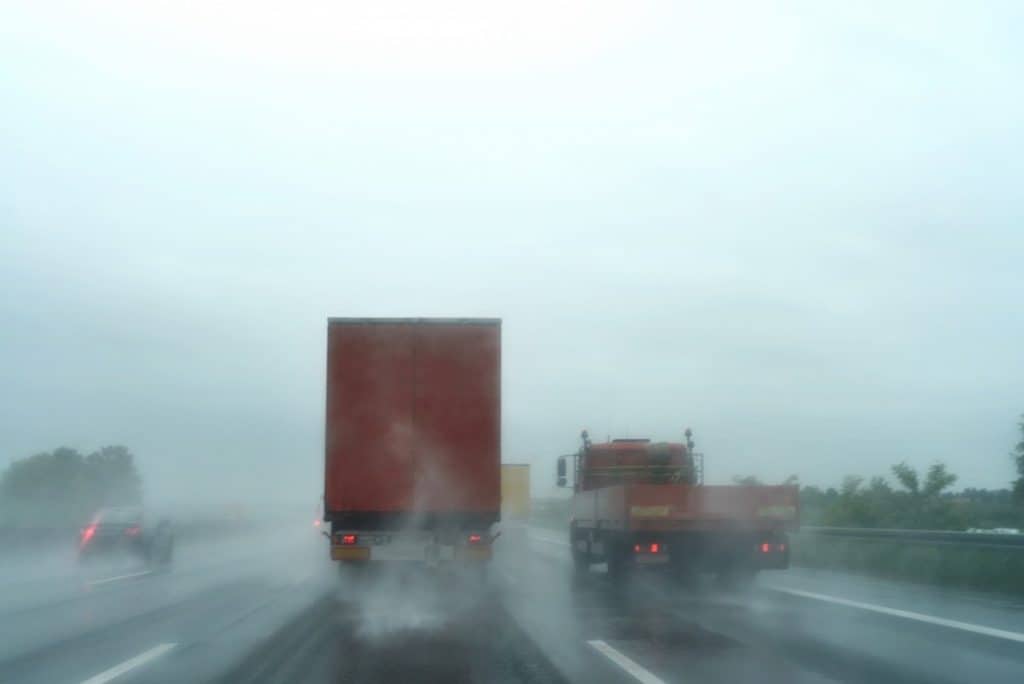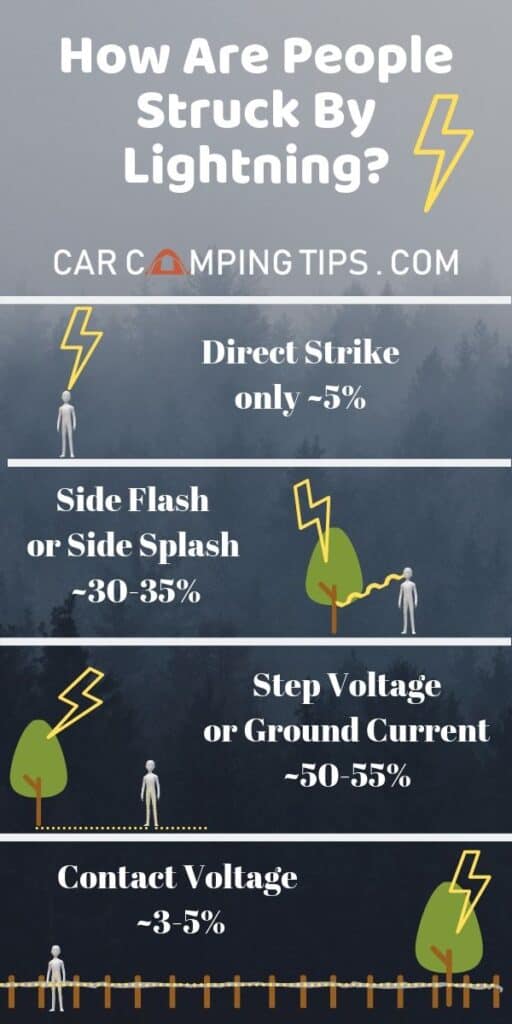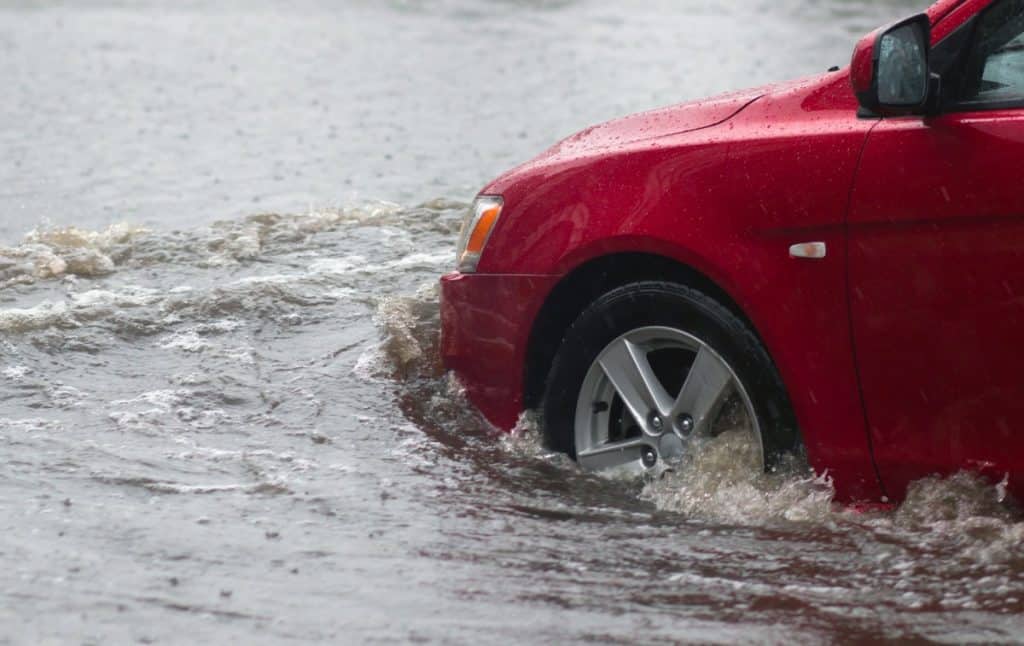Driving a car in a thunderstorm can be terrifying–it’s hard to know what to do with rain, lightning, and high winds all coming at you from the sky. What should you do?
The best thing to do when a severe thunderstorm hits while you’re driving is to find a safe place to pull off the road away from other drivers and from pooling water. Rain is the most dangerous part of the thunderstorm, but it’s important to take precautions against lightning and wind, as well.
How do you know you’re safe from other drivers? What precautions can you take from lightning and wind? Well, keep reading, and you’ll learn what you need to know so you can be safe in a thunderstorm.
By the way, as an Amazon Associate, I earn when buying qualified products through links on my site.

Driving A Car Safely In A Thunderstorm
I live in Texas. One thing I love about this state is the big thunderstorms that roll through on occasion. These thunderstorms dump water so thick you can’t see more than 20 feet, sometimes. And then there are the big thunderclaps and lightning flashes.
Watching a thunderstorm is fun… when you’re not driving in it. My area is also especially sensitive to flash floods, which are when the water floods the roads and rivers extremely quickly (within hours of it starting to rain).
There are lots of things you can do to keep yourself safer while driving in a thunderstorm, so let’s get to them.
Lightning Safety for Driving in a Thunderstorm
A common misconception about lightning is that you’re in most danger of being struck by lightning. The truth is that lightning is so powerful that if you are anywhere near a strike you are still in a lot of danger. This diagram is about being struck as a person, but the concepts still carryover to driving in a thunderstorm. (If you’re wondering about what to do if you get caught in a thunderstorm and you are outside away from your car, check out my article, here.)

So even if lightning strikes a nearby tree while you’re in your car, you could still get zapped.
The safest place to be in a thunderstorm is inside an enclosed (and plumbed) building, away from any fixtures or appliances.
If you are driving on a road trip and you hit a thunderstorm, the next safest place is inside your car (unless you are driving a rag-top convertible)
What to do to stay safe from lightning in your car:
- Pull over the car safely. Make sure to park somewhere as far away from other cars as possible–avoid parking on a curve where there’s a chance another driver could veer off the road and hit you.
- Turn off the engine
- Turn on your emergency lights
- Avoid touching the steering wheel and column as well as the windows or doors.
- Wait till the storm has passed before starting again.
- Do not go outside your vehicle. Your car is the safest place to be.
Why Is Your Car a Safe Place to Be?
Cars are essentially metal cages. If lightning strikes your car or nearby, the electricity will pass through your tires (sorry, the rubber won’t do much with that much electricity), and will disperse inside your car frame. That’s why it’s important to not be touching any part of the car that is connected to the car frame. This phenomenon is called the Faraday Cage effect.
Why Do I Need To Pull Over?
Why not keep driving? Well, one reason you might not have considered is that modern cars are basically computers (that’s why repairing them is so expensive these days). A lightning strike could zap all your car’s electronics, making it completely unusable.
If your car is going to be made unusable, it’s best if that happens when you’re not hurtling down the highway at 65 MPH.
Rain Safety
The riskiest part of driving in a thunderstorm is not the lightning but the rain. Rain (or snow) increases your fatal crash risk by 34%.
Check out this data:
“[…] we find that the overall risk of a fatal crash increases by approximately 34% during [rain or snow].”
Bulletin of the American Meterological Society (link)
This doesn’t mean if it’s raining you have a 1/3 chance of getting in a crash, just that your risk increases a LOT.
In fact, during heavy rain, this same study found that “the risk of a fatal crash during heavy [rain or snow] found to be more than double the […] risk”.
If there’s any thing that you need to know about staying safe in a thunderstorm, it’s learning to either avoid driving in heavy rain, or to drive very carefully.
When you’re driving in the rain you have two major concerns: loss of traction and loss of visibility.
Traction
When the roads are wet, your tires lose some contact with the road and instead makes contact with the water.
What this means is that your vehicle isn’t able to speed up or slow down as effectively–your tires are likely to spin out. This is really common to see at stoplights as people push the gas, suddenly.
The key to maintaining traction in rain is to gently transition speeds. If you lightly press the brakes and if you lightly press the gas, your tires can maintain contact with the road and your car won’t slip as easily.
Loss of Visibility
Besides the loss of traction, when rain is pouring down on your windshield, it’s a lot harder to see–for a few reasons.
First: When it’s raining, it’s much more humid, which can cause your windows to fog up–so you are relying on your defroster (and that you can find the exact setting and temperature to defog your windshield and rear window.) If your windshield is dirty on the inside and it’s humid, this can cause water droplets to accumulate and pair with the dust on the inside of your windshield which makes a nasty glare.
This happens to me all the time. 🙁 I think I should clean my windshield.
Second: the rain itself can be heavy enough that it’s difficult to see. If your windshield wipers are not in perfect working order this makes it even worse. Let’s say it’s pouring rain and your driver windshield wiper is not making a good seal with the windshield because it’s worn–well that means the water on your windshield is going to block your view.
If it’s raining heavily, the absolute best thing to do is pull off in an area that won’t flood (not at the bottom of a gulch or a channel), and wait it out. It’s extremely important to keep your hazard lights on and make sure you don’t park right behind a tree or bend in the road where other cars can’t see you and could hit you in the low-visibility rain.
Flood Safety
During a thunderstorm, rain can come down for hours and it can pour a lot of water in a short amount of time. Some areas of the world are subject to flash flooding.
If a section of the road is covered with water, a really big temptation is to try and cross it in your car. This can be extremely dangerous–if the water is just deep enough, your wheels won’t be able to touch the ground and you and your car might get caught in the flood.

I admit, I have shown a big lack of patience and tried to cross, anyway–it’s tempting to do when you see other drivers do the same.
The right thing to do is wait out the storm and wait for the water to recede or to find another way around the flooding.
Wind Safety
One easily missed danger with thunderstorms is severe wind. Not all thunderstorms have the same level of wind, but some thunderstorms can have gusts of up to 100 miles per hour. (Source: weather.gov). These are winds that can do tornado-level damage.
Weather.gov classifies high winds as sustained winds above 40 mph and actually cautions drivers to not drive unless it’s absolutely necessary.
Wind is much more dangerous for higher profile vehicles (vans, trucks, large SUVs), etc. I know I’ve experienced unexpected veering while driving in high wind conditions. This is especially true if you’re accustomed to driving sedans where you feel the wind much less.
You have to make sure you’re ready for your vehicle to pull unexpectedly in one direction at any moment.
Best Thing To Do While Driving In a Thunderstorm
I wanted to reiterate slightly what I’ve been talking about in this article–mostly because I know how hard it is to stop driving and pull over. It’s really easy to try and muscle through it (especially if you’re late for something). One thing to think about is that in a thunderstorm you are potentially facing three hazards all at once, wind, lightning, and rain.
There’s no shame in pulling over to a safe place and waiting out the thunderstorm–in fact, it could save your life.
Is Being Struck By Lightning Common In A Car?
Out of the deaths analyzed on Weather.gov (source), 5% of deaths were from those riding bicycles, motorcycles, and ATVs. Essentially, vehicles that were open to the air and not an enclosed metal cage.
None of the data showed lightning to be the cause of death in car accidents.
This doesn’t mean that you are completely safe in your car, it might also mean that it’s hard to prove what happened for these car accidents (they would have to know the difference between a lightning strike and distracted driving, for example). But it does show that there wasn’t enough data to list deaths from driving in an enclosed vehicle.
So it might be more common than we think, but cars might absorb the shock and we would never know it.
Another study that analyzed the cause of death for lightning fatalities in Turkey covering data from January 1930 to June 2014 showed that there were two instances where lightning struck and caused a car accident. Using the numbers in this study, for those killed by lightning, those in a car impact made up only 0.5% of all deaths. (5 out of 895).
Lightning Myths
Lightning is a part of our regular lives, but there still are plenty of myths about it that are not well understood.
- Rubber tires protect you from lightning: With the amount of electricity in a bolt of lightning, your tires will still conduct electricity–what keeps you safe is the Faraday cage effect from the metal cage of your car frame.
- Golfing is the most dangerous activity when there’s lightning: It turns out that soccer is the most dangerous sport, but by far the most dangerous activity/sport is fishing/boating. In fact, from 2006-2019, 35% of activities where people died from a lightning strike were water-related (source)
- Tents act like lightning rods: Unless your tent was very tall and pointy, it’s not likely that it will attract a lightning strike unless it’s in an open field with no other taller objects around. For more information about staying safe while camping, make sure and check out our article here on the subject)
- If I’m inside, I’m safe from lightning: This data from weather.gov (linked above) showed that 16% of lightning deaths from 2006-2019 were from daily activities, and some of those were very mundane things like “lowering the blinds on a window, talking on a corded phone […]”, etc. It’s important to be cautious even in your house and avoid contact stuff that’s plugged in and from windows or plumbing.
